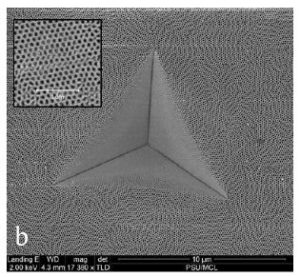Penn State Researchers Measured Mechanical Properties of AAO as a function of Nanoscale Geometry and Crystalline State
At the recent meeting of the Society for the Advancement of Material and Process Engineering (SAMPE), a Pennsylvania State University team led by Professor Namiko Yamamoto, reported a series of careful mechanical measurements on AAO as a function of the pore diameter, porosity and phase composition. Given the importance of ceramics in many industrial applications, there is great interest in gaining a better understanding of their mechanical properties as a function of pore size, porosity, and crystalline state (amorphous and polycrystalline). Using InRedox AAO membranes the team found that elastic modulus (E) and hardness (H) both decreased as porosity increases and this was true for both amorphous and crystalline AAO. For crystalline AAO samples, elastic modulus and hardness increased with increasing pore size or inter-pore distance for the same porosity. Intriguingly, the team observed shear bands in the form of collapsed pores resulting in quasi-ductility when AAO has smaller pore sizes or larger porosity. This newly observed failure mechanism induced by nanoporosity has the potential to dramatically enhance AAO’s ability to dissipate energy and thus increase the fracture toughness. If such toughening can be optimized, these nanoporous ceramics can potentially be used in structural applications in extreme environments, including aero-engines, gas turbines, protection armors, thermal protection tiles and heat exchangers.
The Effect of Nano Pore Size and Porosity on Deformation Behaviors of Anodic Aluminum Oxide Membranes, Jingyao Dai, Jogender Singh, Namiko Yamamoto, SAMPE Seattle 2017, Seattle WA, May 2017.



